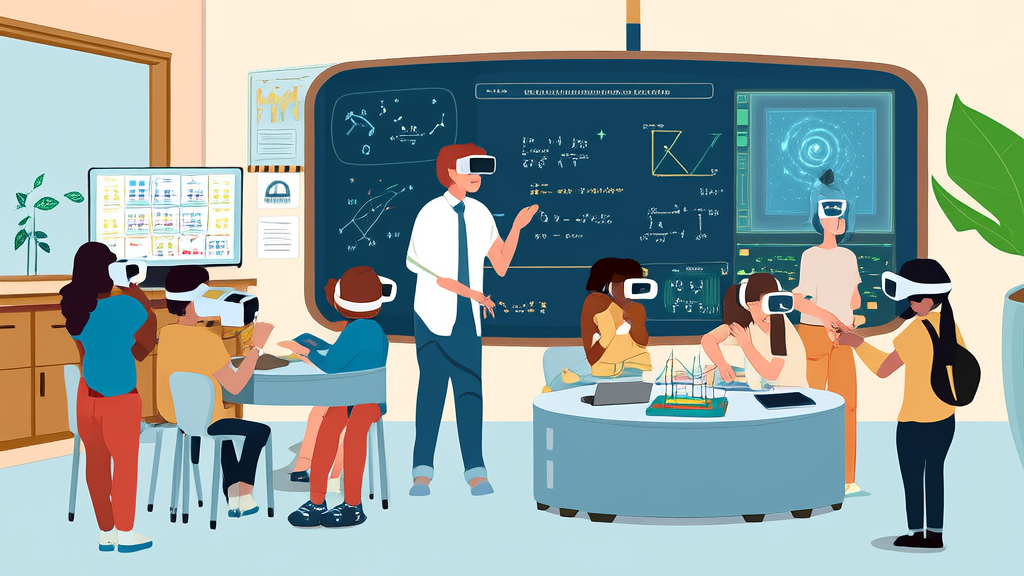5 Cutting-Edge K-12 Teaching Methods Transforming Education in 2025

Empowering the Future: Navigating K-12 Education in 2025
Welcome to the future of education! As we stand in June 2025, the landscape of K-12 education is more dynamic and innovative than ever. From cutting-edge teaching methodologies to groundbreaking educational technologies, the way our children learn is evolving rapidly. This blog post aims to guide parents and educators through the latest trends, insights, and practical tips that can help foster a nurturing and effective learning environment for our young learners.
The Latest Teaching Methodologies and Their Effectiveness
In recent years, there has been a significant shift towards student-centered learning, where the focus is on engaging students in active, hands-on experiences. Project-Based Learning (PBL) and Flipped Classrooms are two prominent methodologies that have gained traction.
Project-Based Learning (PBL): PBL encourages students to explore real-world problems and challenges, fostering critical thinking, collaboration, and problem-solving skills. For example, a science class might tackle a local environmental issue, such as water pollution, by conducting research, designing solutions, and presenting their findings to the community. Studies have shown that PBL can lead to deeper understanding and retention of material, as well as increased student engagement and motivation.
Flipped Classrooms: In this model, traditional lecture and homework elements are reversed. Students watch video lectures or read materials at home, and then use class time for interactive activities, discussions, and problem-solving. This approach allows for more personalized and collaborative learning experiences. Research indicates that flipped classrooms can improve academic performance and reduce achievement gaps.
Child Development Insights and Research
Understanding child development is crucial for creating effective learning environments. Recent research has highlighted the importance of social-emotional learning (SEL) and executive function skills in overall academic success.
Social-Emotional Learning (SEL): SEL focuses on developing self-awareness, self-management, social awareness, relationship skills, and responsible decision-making. Schools that integrate SEL into their curriculum have seen improvements in student behavior, attendance, and academic performance. For instance, the Collaborative for Academic, Social, and Emotional Learning (CASEL) provides resources and frameworks for implementing SEL in schools.
Executive Function Skills: These are cognitive processes that enable us to plan, focus attention, remember instructions, and juggle multiple tasks. Developing these skills in early childhood can have long-lasting benefits. Teachers can support executive function development by providing structured routines, using visual aids, and encouraging goal-setting and reflection.
Educational Technology Trends
Technology continues to play a pivotal role in K-12 education, offering new ways to engage students and enhance learning. Here are some of the most impactful trends:
Artificial Intelligence (AI) and Adaptive Learning: AI-powered tools can provide personalized learning experiences by adapting to each student's unique needs and pace. Platforms like DreamBox and Khan Academy use AI to offer tailored content and feedback, helping students master concepts more effectively.
Virtual and Augmented Reality (VR/AR): VR and AR technologies are transforming the way students experience and interact with educational content. For example, virtual field trips can take students to historical sites, scientific phenomena, or even outer space, making learning more immersive and memorable.
Gamification: Gamifying the learning process can make it more fun and engaging. Educational games and apps, such as Minecraft: Education Edition and Duolingo, use game mechanics to teach subjects like math, language, and coding, while also promoting collaboration and creativity.
Practical Tips for Parents and Teachers
Here are some actionable tips to help parents and teachers create a supportive and enriching learning environment:
- Stay Informed: Keep up with the latest research and trends in education. Attend workshops, webinars, and conferences, and join professional networks to share best practices and resources.
- Communicate Regularly: Maintain open lines of communication between home and school. Regular check-ins, parent-teacher conferences, and digital platforms can help keep everyone informed and involved.
- Encourage Curiosity: Foster a love of learning by encouraging questions, exploration, and hands-on activities. Create a home environment that supports reading, experimentation, and creative expression.
- Support Mental Health: Prioritize the social and emotional well-being of students. Provide access to counseling services, mindfulness practices, and stress-reduction techniques. Encourage a balanced approach to academics and extracurricular activities.
Success Stories and Case Studies
Real-world examples can inspire and inform. Here are a couple of success stories from schools that have implemented innovative approaches:
Case Study 1: The Green School, Bali: This school integrates sustainability and environmental stewardship into its curriculum. Students engage in projects like organic farming, renewable energy, and waste management. The Green School has been recognized for its holistic approach to education, which not only enhances academic performance but also instills a sense of responsibility and global citizenship.
Case Study 2: Summit Public Schools, California: Summit uses a personalized learning platform that combines technology, project-based learning, and mentorship. Students set goals, track their progress, and receive individualized support. This approach has led to higher graduation rates, improved college readiness, and greater student satisfaction.
Conclusion
The world of K-12 education is constantly evolving, and staying informed about the latest methodologies, research, and technologies is essential for both parents and educators. By embracing innovative approaches and supporting the holistic development of our children, we can create a brighter and more promising future. Let’s work together to empower the next generation of learners and leaders.
For more information and resources, consider joining online communities, attending educational events, and exploring the wealth of available literature and tools. Together, we can make a difference in the lives of our students.